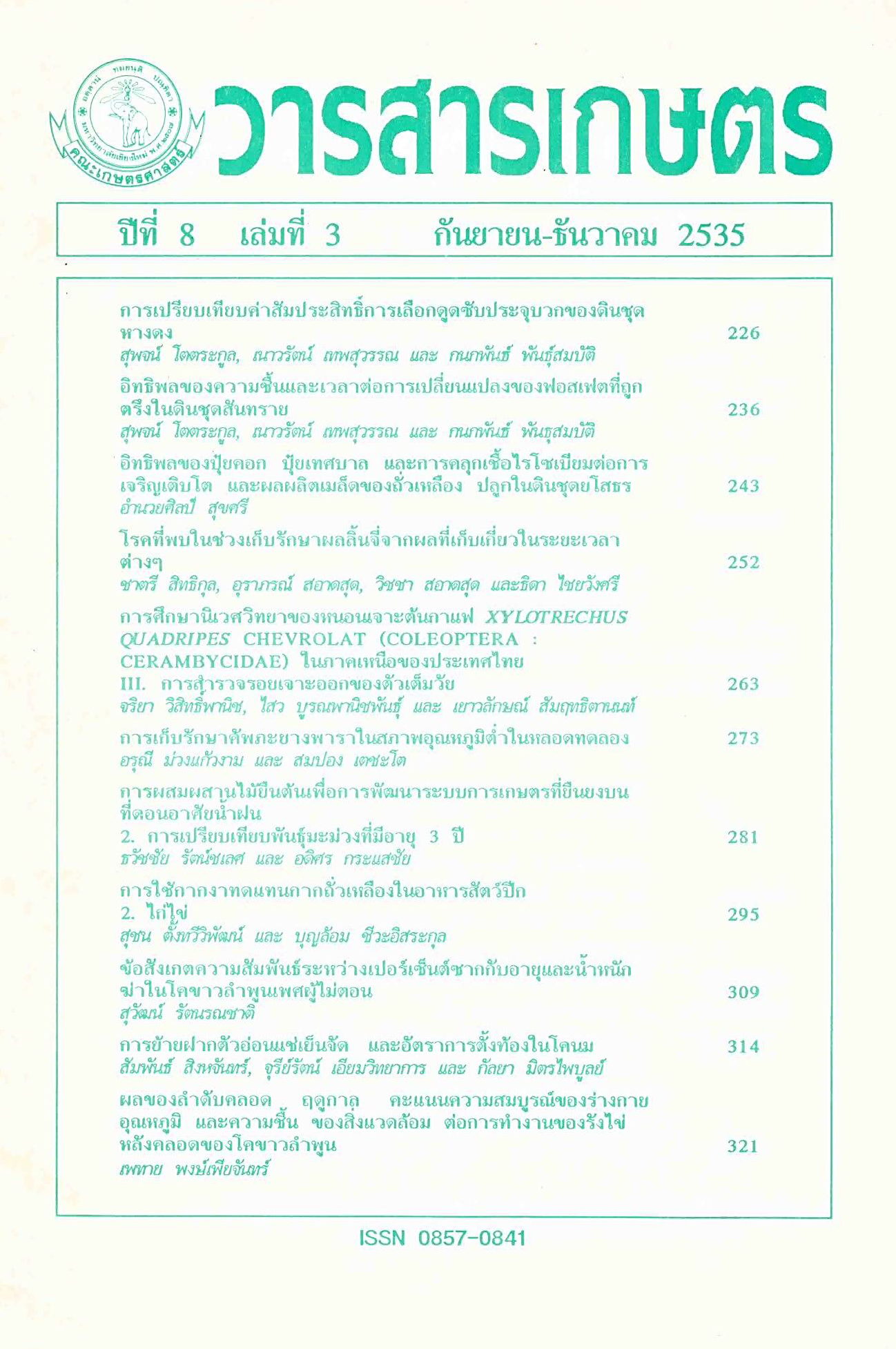ผลของลำดับคลอดฤดูกาลคะแนนความสมบูรณ์ของร่างกายอุณหภูมิและความชื้นของสิ่งแวดล้อมต่อการทำงานของรังไข่หลังคลอดของโคขาวลำพูน
Main Article Content
บทคัดย่อ
การทดลองครั้งนี้ ใช้โคขาวลำพูนซึ่งเป็นโคพื้นเมืองในเขตภาคเหนือตอนบน ของประเทศไทยเป็นสัตว์ทดลอง โดยมีวัตถุประสงค์เพื่อ: (1) เปรียบเทียบผลของลำดับคลอด (Parity), ฤดูกาล, อุณหภูมิ ความชื้น (THl), การเปลี่ยนแปลงน้ำหนักตัว (BWC) และคะแนนความสมบูรณ์ของร่างกาย (BCS) ต่อการทำงานของรังไข่หลังคลอด (POA) (2) ลดระยะเวลาระหว่างวันคลอดลูก กับวันเป็นสัดครั้งแรกหลังคลอด โดยการเสริมแร่ธาตุปลีกย่อย, แคลเซียม และ ฟอสฟอรัส (3) เปรียบเทียบอุณหภูมิทวาร (Rectal temperature) ระหว่างโคพันธุ์โฮลสไตน์ฟรีเชี่ยนxพื้นเมือง กับโคขาวลำพูน ภายใต้สภาพความเครียดเนื่องจากอุณหภูมิสูง, โคทดลองมี 2 กลุ่ม : กลุ่มแรก เป็นโคที่ สถานีวิจัยและฝึกงานแม่เหียะ ภาควิชาสัตวบาล คณะเกษตรศาสตร์มหาวิทยาลัยเชียงใหม่ จำนวน 62 ตัว; กลุ่มที่สอง เป็นโคขาวลำพูน ในหมู่บ้าน เขตจังหวัดเชียงใหม่ จำนวน 18 ตัว แบ่งเป็น 3 กลุ่มทดลองละ 6 ตัว ประกอบด้วย กลุ่มควบคุม กลุ่มเสริมแร่ธาตุปลีกย่อย และกลุ่มเสริมแร่ธาตุปลีกย่อย + แคลเซียมและฟอสฟอรัส. โคทดลองทั้งในสถานีวิจัยฯ และในหมู่บ้าน กินอาหารจากแปลงหญ้าธรรมชาติในเวลากลางวันเป็นหลัก เวลากลางคืนโคอยู่ในโรงเรือน. การเก็บตัวอย่างน้ำนม หรือพลาสม่าสำหรับวิเคราะห์หาระดับฮอร์โมนโปรเจสเตอร์โรน (Progesterone) โดยวิธีเรดิโออิมมูนโนแอสเซ (RIA) เพื่อวัดการทำงานของรังไข่. ผลการศึกษาที่สถานีวิจัยพบว่า: จำนวนโคคิดเป็นเปอร์เซนต์สะสม (Cummulative percentage) ที่มี POA ครั้งแรกเมื่อ 10-20, 21-40, 41-60, 61-80, 81-100, 101-120, 121-140 และ มากกว่า 140 วันหลังคลอด เป็น 12.9, 48.4, 61.3, 74.2, 8.5, 93.5, 98.4 และ 100 เปอร์เซนต์ตามลำดับ. ลำดับคลอดไม่มีผลต่อค่า OA แต่สำหรับอัตราการตั้งท้อง ระหว่างลำดับคลอด 1-2 vs 3-6 และ 1-3 vs 4-6 มีค่า 13.3 vs 51.1 และ 21.7 vs 53.8 เปอร์เซนต์ ตามลำดับ (P <.05). ค่า BCS ในฤดูร้อน-ชื้น (มิถุนายน-กันยายน) มีค่า 2.96 ± 0.12 ต่ำกว่าในฤดูหนาวแห้ง (ตุลาคม-กุมภาพันธุ์) และฤดูร้อน-แห้ง (มีนาคม-พฤษภาคม) ซึ่งมีค่า 3.51 ± 0.07 และ 3.73 ± 0.12 ตามลำดับ (P <.05). สำหรับผลของความเครียดเนื่องจากความร้อน และความชื้นวัดเป็นด่า Temperature humidity index (THI) พบว่ามีสหสัมพันธ์ทางบวกระหว่างค่า THI และ BCS (r2= 0.33, P < .0.5).ไม่พบสหสัมพันธ์ระหว่าง BCS vs POA, BWC vs POA และ BWC vs BCS (P<05), อุณหภูมิทวาร ของโค โฮลสไตน์ฟรีเชี่ยน x พื้นเมือง และโคขาวลำพูนเมื่อเวลา 8:30 นาฬิกา มีค่า 37.8 ± 0.07 และ 38.0: 0.10 °C ในเวลา 15:30 นาฬิกา มีค่า 38.9 ± 0.08 และ 38.7 ± 0.11 °C ตามลำดับ. การทดลองในหมู่บ้านการเสริมแร่ธาตุปลีกย่อย และเสริมแร่ธาตุปลีกย่อย+ แคลเซียมและฟอสฟอรัส มีแนวโน้มที่จะทำให้จำนวนวันระหว่างวันคลอดลูก กับวันผสมพันธุ์ครั้งแรกหลังคลอดสั้นลง การศึกษาครั้งนี้ได้แสดงให้เห็นว่าโคขาวลำพูน เป็นพันธุ์ที่สามารถสืบพันธุ์ได้ดีภายใต้สภาพแวดล้อมที่มีอุณหภูมิ และความชื้นสูง.
Article Details
เอกสารอ้างอิง
Apichartsrungkoon, T. and Pongpiachan, P. (1990). Use of milk progesterone profile for the study of fertility in the postpartum period of dairy cows. J. Agriculture 6: 219-225.
Bianca, W. (1962). Relative importance of dry- and wet-bulb temperatures in causing heat stress in cattle. Nature, Lond. 195: 251-252.
Boer, G.D., Etches, R.J. and Walton, J.S. (1980). A solid-phase radioimmunoassay for progesterone in bovine serum plasma. Can. J. Anim. Sci. 60: 783-786.
Butler, W.R., Everett, R.W. and Coppock, C.E. (1981). The relationship between energy balance, milk production and ovulation in postpartum Holstein cows. J. Anim. Sci. 53: 742–748.
Butler, W.R. and Smith, R.D. (1989). Interrelationships between energy balance and postpartum reproductive function in dairy cattle. J. Dairy Sci. 72: 767-783.
Cheva-Isarakul, B. and Euchiewchankit, K. (1991). Mineral nutrition of ruminant in Thailand. J. Agriculture. 7: 251-266.
Dunn, T.G., Ingalls, J.E., Zimmerman, D.R. and Wiltbank, J.N. (1969). Reproductive performance of 2-year-old Hereford and Angus heifers as influences by pre- and post-calving energy intake. J. Anim. Sci. 29: 719-726.
Dunn, T.G. and Moss, G.E. (1992). Effects of nutrient defficiencies and excesses on reproductive efficiency of livestock. J. Anim. Sci. 70: 1580-1593.
Frisch, J.E. (1986). Lecture on: Improvement of reproductive rate of large ruminant, 17 October1986, Chiang Mai University, Thailand.
Fuquay, J.W. (1981). Heat stress as it affects animal production, J. Anim. Sci. 52: 164-174.
Harvey, W.R. (1975). Least-squares analysis of data with unequal subclass numbers, Agricultural Research Service, No. ARS H- 4, U.S. Department of Agriculture.
Ingraham, R.H., Gillette, D.D. and Wagner, W.D. (1974). Relationship of temperature and humidity to conception rate of Holstein cows in subtropical climate. J. Dairy Sci. 57: 476-481.
International Atomic Energy Agency. (1984). Laboratory Training Manual on Radioimmunoassay in Animal Reproduction, Technical Reports Series No. 233. Vienna, p. 169-173.
Kamonpatana, M., Srisakwattana, K. and Sophon, S. (1988). Pregnancy Diagnosis from Milk Sample. Kamonpatana, M., Srisakwattana, K., Sophon, S., Sravasi, S. and Parnpai, R., (eds.), Chulalongkorn University Press, Bangkok. p.73–126.
Lishman, A.W., Allison, S.M.J., Fogwell, R.L., Butcher, R.L. and Inskeep, E.K. (1979). Follicle development and function of induced corpora lutea in underfed postpartum oestrous beef cows. J. Anim. Sci. 48: 867-875.
McDowell, R.E. (1968). Climate versus man and his animals. Nature 218: 641-645.
Meisterling, E.M. and Dailey, R.A. (1987). Use of concentrations of progesterone and estradiol-
17beta in milk in monitoring postpartum ovarian function in dairy cows. J. Dairy Sci. 70: 2154-2161.
Rhodes III, R.C., Randel, R.D. and Long, C.R. (1982). Corpus luteum function in the bovine: In vivo and in vitro evidence for both a seasonal and breed type effect. J. Anim. Sci. 55: 159-167.
Ryan, D.P., Boland, M.P., Kopel, E., Armstrong, D., Munyakazi, L., Godke, R.A. and Ingraham, R.H. (1992). Evaluating two different evaporative cooling management systems for dairy cows in a hot, dry climate. J. Dairy Sci. 75: 1052–1059.
Snedecor, G.W. and Cochran, W.G. (1967). Statistical Methods. The lowa State University Press. Ames, Iowa.
Staples, C.R., Thatcher, W.W. and Clark, J.H. (1990). Relationship between ovarian activity and energy status during the early postpartum period of high producing cows. J. Dairy Sci. 73: 938-947.
Steel, R.G.D. and Torrie, J.H. (1962). Principles and Procedures of Statistics. McGraw-Hill Book Co., Inc., New York.
Stoebel, D.P. and Moberge, G.P. (1979). Effect of ACTH and cortisol on estrus behavior and the luteinizing hormone surge in the cow. Fed. Proc. 38: 1254.
Vearasilp, T. (1979). Cattle and buffalo's market. Buffalo Bulletin 2 (April-June): 42-46. (in Thai). Wildman, E.E, Jouh, G.M., Wagner, P.E., Boman, R.L., Troutt, H.F., and Lesch, H.F. (1982). A dairy cow body condition scoring system and its relationship to selected production characteristics. J. Dairy Sci. 65: 495-501.
Williams, G.L. and Ray, D.E. (1980). Hormonal and reproductive profiles of early postpartum beef heifers after prolactin suppression or steroid-induced luteal function. J. Anim. Sci. 50: 906- 918.


